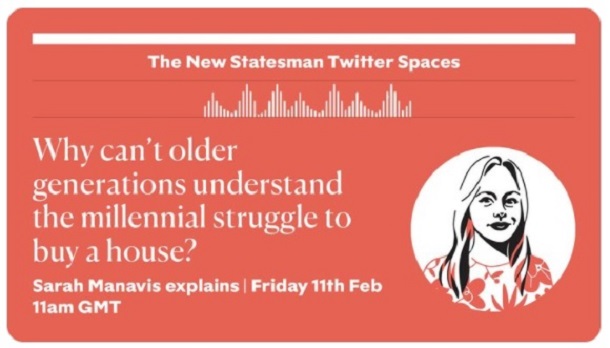
Spaces - live audio conversations hosted directly on Twitter - were only launched one year ago but many publishers (as well as private individuals, since the tool was rolled out to all users last October) are already experimenting with the platform.
One advantage is that, compared to hosting a virtual event over a platform like Zoom, the set-up is relatively simple, because this all happens within Twitter, rather than spending time managing sign-ups.
However, planning the content and hosting the Space still takes time and effort, so any newsroom needs to evaluate whether it fits into its audience and revenue strategy.
Visibility
"As most news publishers have a built-up and established presence on Twitter, you already have an engaged audience that is there and often wanting to hear more from your outlet or journalists," Heather Bowen, senior manager, news partnerships at Twitter, told Journalism.co.uk.
You can Tweet out a link to a scheduled Space beforehand, and when you go live, it is highlighted at the top of the timeline to ot only your own followers but to your speakers' followers too.
According to Bowen, this provides a significant extra level of visibility. "It's prime real estate shown to people the second they come to find out what's happening [by logging on to Twitter] and, now, your Spaces can live even longer through the Recording functionality too," she said.
The New Statesman is among those publishers which have used Spaces, both for discussion of topical news articles as well as lifestyle and opinion pieces. Elise Johnson, head of audience, said that this has had a visible effect on website traffic.
"We've seen if we do a Spaces on a subject that is popular with our audience, that not only do we get more people driven back to our website, but follow-up articles on that subject will perform better on social media too as we've established more authority on the subject," she said.
At membership-funded 'slow' newsroom Tortoise, head of social Andrew Butler said the tool complements their ethos of being open and welcoming. He sees benefits from Twitter Spaces both in terms of reaching new audiences and engaging with existing readers in a new way.
"We're aware that a fair few people on Twitter won't be aware of what Tortoise is or what we do, but they might tune in because they like the sound of the topic we're discussing," he said.
"We like to show our members and listeners how we've produced our journalism and what we are thinking about. Using Twitter Spaces for people to join in a conversation about what we've been discussing in our editorial conferences, or talking about a story we've produced, is a natural extension of our newsroom."

Screengrab: New Statesman on Twitter
Talking directly to the audience
Butler says that a successful Space goes beyond reach and involves readers in the conversations. Publishers can control who has the ability to speak in their Space, so anyone who takes can part can ask to speak and it is up to the host whether to pass them the mic. This suits the open ethos of Tortoise.
"We had a discussion a few weeks ago about drug use in sport, and someone requested to speak, and it turns out they were part of a congressional committee who had been part of policy making about anti-doping," he explains.
"He had so much to offer, and just saw that we were talking about an issue he was an expert in, so decided to join. It was an excellent example of when Twitter Spaces really works."
An extra feature on Butler's wish list is a live chat function, based on Tortoise's experience from two years of virtual events that some people have valuable insights to contribute but may not want to speak 'publicly'.
Subscription funnel
Twitter is currently developing options to make money directly on Spaces, either by making them available only to people who buy tickets (for now, ticketed Spaces are only available in the US), or by using Sponsored Spaces where publishers can use Twitter Amplify to get brand sponsorship for their Space.
However, at the newsrooms we spoke to, the big appeal of Spaces is in reaching new audiences and gaining reach as a conversation-starter.
"I personally don't see Subscriber Spaces or Paid Spaces as the future of this tool. Twitter is an open platform where virality exists, therefore Spaces is powerful in that context. The openness and collaborative comments is what makes Spaces intriguing," Johnson at the New Statesman said.
"Twitter should lean into the USP when thinking about the evolution of this platform. Limiting Spaces to paid customers would stifle the fun."
Instead, she would like Twitter to enhance the analytics available from Spaces, so that her team can learn more about the people who interact with them on this platform. It's the same story at Tortoise, where Twitter Spaces adds another touchpoint on users' journeys, helping to grow familiarity and trust.
"By using a platform that a potential audience is already on, we want them to hear and contribute to our discussions on Spaces and think, 'Yeah, I like the sound of that, I want to know more or participate more', and then join Tortoise as a member," says Butler.
Network with your peers and learn from industry experts at our upcoming digital journalism conference Newsrewired, taking place on 24 May at News UK's stunning 17th-floor building in London. Grab your ticket today
Free daily newsletter
If you like our news and feature articles, you can sign up to receive our free daily (Mon-Fri) email newsletter (mobile friendly).
Related articles
- Six self-care tips for journalists to stay sane during the general election
- RISJ Digital News Report 2024: Three essential points for your newsroom
- Seven tips for using LinkedIn as a freelance journalist
- Journalists are happy to be disconnecting from platforms, should news organisations be worried?
- Protecting journalists on social media, with Valérie Bélair-Gagnon









